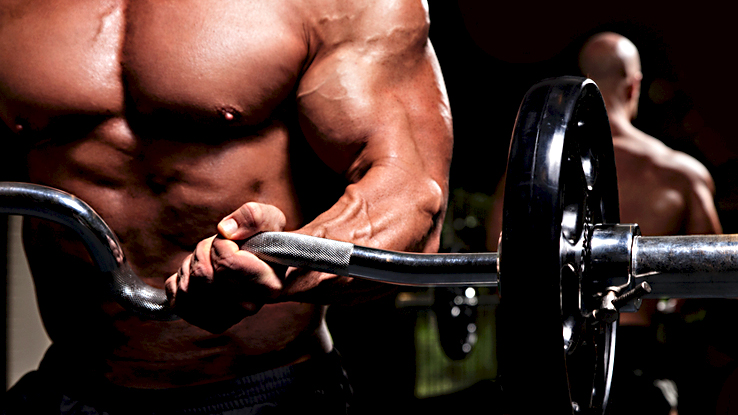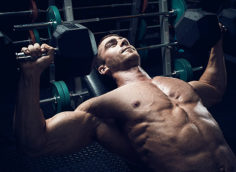At some point during the last decade, direct arm training became a dirty phrase. Anyone who wasted precious training time on "nonfunctional" isolation exercises was immediately labeled stupid, vain, or behind the times.
I'm all for intelligent programming, but let's get real – biceps curls don't turn people into raging douchebags. Direct arm work can and should be a part of any well-rounded "functional" routine.
Just to be clear, I'm not saying that direct arm work should displace heavy, compound, multi-joint movements like squats, deadlifts, presses, chin-ups, and rows. I'm saying that it's time we cut the elitist bullshit that makes it okay to isolate the anterior fibers of your gluteus medius but wrong to do a triceps pushdown.
Here are some recommendations to get you started on the road to restoring your arms to their former glory.
Barbell Cheat Curls

Some might write-off the cheat curl as misplaced weight room bravado, but that doesn't change the fact that muscles respond best to heavy overload. And in that department, nothing touches the cheat curl.
Arnold, who sported arguably the best set of biceps the world has ever known, was a huge proponent of the cheat curl and considered it the champion of mass-building biceps exercises.
The "cheat" – a slight bump from the hips to jumpstart the movement of the bar – provides just enough initial momentum to get past any sticking points. This way you can hit the biceps' optimal position for force generation – about 40 degrees of elbow flexion – with a weight that it rarely encounters in any other exercise.
Although the amount of weight used in the cheat curl might be considered supramaximal for the concentric portion of the exercise, it's often just right to maximally stress the stronger eccentric portion of the movement.
Unfortunately, exercises that specifically stress the eccentric loading phase are conspicuously missing from most programs. Heavy eccentrics cause low-level muscular trauma, which initiates satellite cell proliferation, new fiber synthesis, and adaptations that enhance muscle fiber size and force production.
Make sure you select a weight that's heavy enough to truly overload the muscle – usually about 15-20% more than your strict curl weight – but not so heavy that it turns into a back and leg exercise. It shouldn't look like you're trying to pull off a standing reverse-grip bench press variation.
Parallel Fat-Grip Pull-ups

Along with being a phenomenal upper back/lat development exercise, the parallel or neutral grip pull-up is one of the most effective biceps exercises for generating both peak and mean muscle activation. Simply put, it's one of the best exercises you can do to stimulate a large number of muscle fibers to produce consistently high levels of force.
I like to use a narrow grip width to maximize range-of-motion at the shoulder and elbow, and a 5-second eccentric tempo to emphasize the lengthening contraction as the elbows go into full extension.
Using a fat grip imposes a heavy tax on the forearms and biceps, ensuring that arm strength, not back strength, is the limiting factor of the exercise. Grip strength plays an obvious and important role that should become very apparent by the fifth or sixth rep.
Incline Bench Dumbbell Curls

The incline dumbbell curl is performed sitting on an incline bench set at approximately a 45-degree angle. Your arms should hang down perpendicular to the ground and slightly behind the rest of the body. This start position has two effects.
First, it makes it virtually impossible to gain any momentum from the back or upward lift from the shoulder, placing 100% of the burden on the biceps. As a result, you'll probably want to decrease the amount of weight you would use for a traditional dumbbell curl by 10 to 15%.
Second, and more interestingly, the start position of the exercise places both the shoulder and elbow in full extension, thus stretching the proximal and distal attachments of the biceps. Animal studies suggest that these type of loaded-stretch positions could lead to muscle fiber hyperplasia, or an increase in the number of muscle cells by way of one large muscle fiber splitting into two smaller fibers.
This is a fundamentally different and slightly more controversial mechanism from hypertrophy, whereby muscle cells simply increase in size. Human study evidence presents similar findings, although less conclusive.
Whether the incline dumbbell curl is actually a sufficient stimulus to bring on hyperplasia is uncertain, but the possibilities are certainly interesting.
Close-Grip Bench Press

The close-grip bench press is one of the most successful crossover stars that the strength and conditioning world has ever known. It's a staple in nearly every bodybuilding, powerlifting, and sports-performance program I've seen.
Similar to the parallel grip pull-up for the biceps, this exercise brings the collective strength of your entire upper body to the table for the triceps to take advantage of, allowing you to handle much heavier weights and overload the muscle.
Along with the traditional close-grip press – which uses a standard barbell lowered to the chest – you can also use an EZ-curl bar, which takes pressure off the wrists, or two-boards against the chest. The board press limits the range of motion and stresses the elbow lockout position, thus maximizing the contribution of the triceps.
Whatever version you opt for, make sure to keep the weights heavy and the reps in the 6-8 range.
Chain Loaded Skullcrusher
Apart from holding the title of the Best Name for an Exercise Ever, this twist on the old school skullcrusher uses accommodating resistance to maximally stress the peak contraction point – elbow extension – while mercifully sparing the wrists and elbows from being locked in place by a barbell.
Along with the joint-sparing benefits, the movement of the chain also adds an element of dynamic instability since the links of the chain swing as you move through the range-of-motion. This unstable environment can be useful to turn on the rotator cuff apparatus, acting as a type of quasi-perturbation.
To set this exercise up you'll need two pieces of 4-5 foot lengths of chain, 20-25 pounds each, and two standard wrist straps. Thread one strap through the last rings of each chain and then back through. This will effectively close the circle and cut the length of chain in half. Wrap the remaining portion of the wrist strap around your hands to serve as a handle for the chain loop.
TRX Weighted Triceps Press
The TRX triceps press is a lot like the skullcrusher, but with some important differences.
First, it allows for greater shoulder flexion, approximating the full overhead position. This maximally stretches the long head of the triceps, positioning it to take on the lion's share of the workload.
Second, it's performed in a closed kinetic chain environment – you have to move your body around the resistance, rather than moving it through the resistance – which has a higher carryover rate to open chain exercises.
Last, there's an obvious demand on core stability that's not present during the skullcrusher. Any exercise the ties together the triceps, shoulders, and abdominals is a win in my book. For added difficulty add a weight vest or two.
Dumbbell Farmer's Carry

The famer's carry is the granddaddy of grip/forearm training exercises. It's the archetype for simple, low-tech, full-body, heavy-loaded, self-limiting exercise.
Perhaps the most important piece of advice I can give is to treat carries like any other mass building exercise and limit the total time it takes to complete the set to 15-20 seconds. Otherwise you're not really building grip strength, you're just building grip endurance. Furthermore, if you can hold onto a weight for longer than 30 seconds, it's probably too light.
Reverse Curl with Wrist Extension

My love affair with the reverse curl started in high school after I read a Sports Illustrated feature on former Chicago Bears defensive lineman Alonzo Spellman's workout routine. The article claimed that Spellman would finish off his arm workouts by performing sets of 240-pound reverse curls.
I'm not sure how much truth there was to the claim, but the picture next to the article of Spellman with his gigantic arms crossed in front of his body lent the story a lot of credibility.
The overhand grip on the bar primarily stresses the brachialis and brachioradialis, located underneath the biceps and on the front of the forearm respectively. To emphasize the lower arm musculature, add some extra wrist extension at the top of movement.
It's time we drop the snobby attitude about direct arm exercises – or dare I say isolation training – and bring the needle back to center. Adding one or two arm exercises at the end of your workout can be a great way to bring-up the poundage on your main lifts and round out your program.
- Valero MC et al. Eccentric Exercise Facilitates Mesenchymal Stem Cell Appearance in Skeletal Muscle. PLoS One. 2012;7(1):e29760.
- Alway SE et al. Regionalized adaptations and muscle finer proliferation in stretch-induced enlargement. J Appl Physiol (1985). 1989 Feb;66(2):771-81.
- Alway SE et al.) Contrasts in muscle and myofibers of elite male and female bodybuilders. J Appl Physiol. 1989 Jul;67(1):24-31.
- Antonio J et al. The role of fiber hypertrophy and hyperplasia in intermittently stretched avain muscle. J Appl Physiol (1985). 1993 Apr;74(4):1893-8.
- Antonio J et al. Muscle fiber splitting in stretch-enlarged avian muscle. Med Sci Sports Exerc. 1994 Aug;26(8):973-977.





